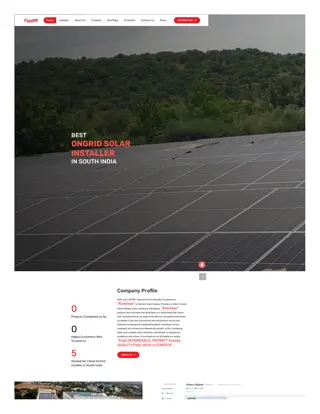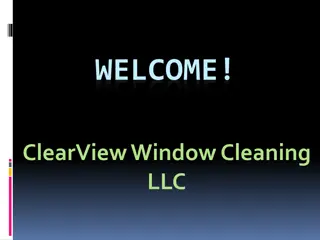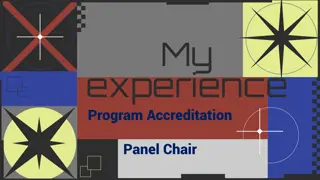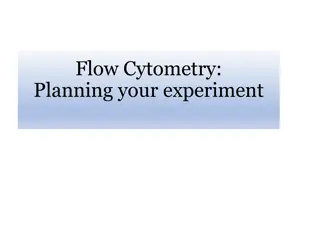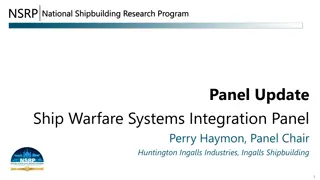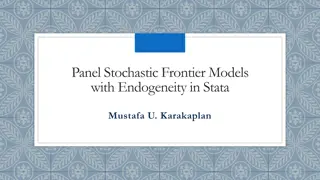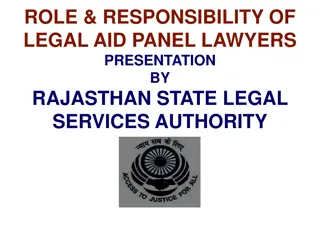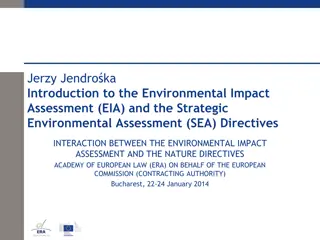Technology & Economic Assessment Panel
The TEAP 2014 Assessment Report highlights the success of the Montreal Protocol in fostering new technology and transitioning away from harmful substances like CFCs and HCFCs. The report emphasizes the need for continued vigilance in tackling sector challenges and making responsible technology choices to preserve the ozone and climate benefits achieved. The assessment identifies advancements in various sectors and provides insights on the status of process agents, solvents, and emissions. Overall, the report underscores the Protocol's effectiveness while calling for sustained efforts to safeguard the environment.
Download Presentation

Please find below an Image/Link to download the presentation.
The content on the website is provided AS IS for your information and personal use only. It may not be sold, licensed, or shared on other websites without obtaining consent from the author.If you encounter any issues during the download, it is possible that the publisher has removed the file from their server.
You are allowed to download the files provided on this website for personal or commercial use, subject to the condition that they are used lawfully. All files are the property of their respective owners.
The content on the website is provided AS IS for your information and personal use only. It may not be sold, licensed, or shared on other websites without obtaining consent from the author.
E N D
Presentation Transcript
TEAP Assessment Key Messages The Montreal Protocol is working Controls create incentives for new technology Widespread implementation of new technology MLF meeting incremental costs of A5 transition Significant technical progress in transitions across all sectors Approaching phase-out of CFC MDIs and controlled uses of MBr HCFC phase-out progressing; HPMPs generally running smoothly Both Ozone- and Climate-friendly options continue to emerge Continued vigilance needed on remaining sector challenges and technology choices, to avoid nullifying ozone and climate benefits achieved under the Protocol
TEAP and its Technical Options Committees The Technology and Economic Assessment Panel (TEAP) has six Technical Options Committees: Chemicals TOC Foams TOC Halons TOC Medical TOC Methyl Bromide TOC Refrigeration, AC and Heat Pumps TOC
2014 Assessment Report Chemicals Technical Options Committee Co-chairs Keiichi Ohnishi and Zhang Jianjun
Chemicals TOC Current Status Process Agents Existing ODS uses are long-standing and are difficult to replace. Feedstock Use Governments and industry are making successful efforts to minimize emissions associated with ODS use in feedstock applications. An overview is provided to assist Parties to limit environmental impacts. Lab and Analytical Use Extensive information has been provided over the last decade on laboratory and analytical methods that do not use ODS, and some progress in implementing alternatives has been reported by Parties.
Chemicals TOC Current Status Solvents Solvent use of ODS has decreased substantially so that very few uses remain and alternative solvents are widely available. The choice of an alternative may be limited by occupational health and safety regulations since many solvents are toxic. Destruction Several destruction technologies were reviewed and shown to meet Montreal Protocol criteria. CTC and Dichloromethane emissions Several emission sources of CTC which include natural sources, pollutant releases, chemical production as by-product , and legacy sources have been studied, but an unexplained discrepancy remains. Dichloromethane emissions have been increasing since 2006. Most of the increase seems to be attributed to solvent uses.
Chemicals TOC: The Way Forward (1) Process Agents: ODS uses will decline as products using them become obsolete. Feedstock Use: CTOC will continue to monitor the use of ODS as feedstocks, and estimate emissions. Lab and Analytical Uses: Non-ODS alternative methods are now available. Parties could consider ways to complete the transition away from ODS.
Chemicals TOC: The Way Forward (2) Solvents Challenge to phase out of ODS solvents in Article 5 Parties (especially SMEs) Destruction If Parties wish to address ODS destruction issues, CTOC will need to involve additional expertise CTC and Dichloromethane emissions CTOC will continue to work with the Science Panel to try to understand CTC discrepancy CTOC will study the emission sources of dichloromethane.
2014 Assessment Report Foams Technical Options Committee former Co-chairs Paul Ashford, Miguel Quintero
Foams TOC Current Status Growth in thermal insulation in Article 5 Parties is occurring owing to increase in construction activity, and adoption of enhanced energy efficiency criteria for buildings Insulation foams are the material of choice but concerns over flammability persist, especially where construction methods create hazards. This is forcing further differentiation between foam types in some regions In non-Article 5 Parties, an increasing focus for insulation use has been existing buildings, where solutions need to be efficient and cost-effective Global blowing agent consumption is estimated at ~390,000 tonnes/year in 2014; expected to grow at around 4.8%/year through to 2020; hydrocarbons will be > 50% of the total
Foams TOC Current Status Decision XIX/6 has driven blowing agent transitions since 2010. Stage 1 HPMPs have been delayed by administrative procedures in some regions HCFC phase-out in foams has focussed on HCFC-141b, based on the worst first principle. However, this has led to continued use of HCFC-142b/22 in the XPS sector which has grown rapidly since 2010, particularly in Asia XPS growth may have caused a nominal breach in the 2013 freeze for Article 5 parties when taking the foam sector in isolation. However, this is unlikely to show at the reporting level because of reductions within other sectors of HCFC use Lack of economies of scale for many SMEs both in A5 and non-A5 parties prevents the investment in highly flammable solutions, leaving CO2 (water), high GWP HFCs, and unsaturated HFC/HCFCs as available options
Foams TOC Current Status New product development is focused on unsaturated HFC/HCFCs (HFOs) HFO-1234ze is already established as the major gaseous blowing agent for XPS and PU The liquid blowing agent HFO-1233zd(E) has been successfully introduced in domestic refrigeration with energy efficiency improvements Two producers focus on this molecule with one producer being already on stream It is also a non-flammable option to replace HCFC-141b and saturated HFC for SMEs HFO-1336mzz(Z), a further liquid blowing agent, available in small quantities with large commercial supply anticipated by 2016 Cost of HFOs may be a barrier unless formulation efficiencies can be found (e.g. blending or co-blowing) Other options: HC /HFO blends HFO systems co-blown with water Improved water formulations
Foams TOC: The Way Forward Annual consumption of blowing agents is predicted to be in excess of 520,000 tonnes by 2020, so tracking choices remains important. Banks of blowing agents are estimated at 4.45 million tonnes in 2014 and are predicted to exceed 5 million tonnes (including hydrocarbons) by 2020 Most ODS in banks will already be in the waste stream by 2020, as products with more limited lifecycles (e.g. appliances) reach end-of-life The average GWP of blowing agents in the waste stream will only further decline in the period to 2020, making the economic justification for the recovery more challenging FTOC will continue to assess low GWP options and track efforts to minimise the future consumption of high GWP blowing agents (both HCFCs and HFCs) which will ultimately deliver additional climate benefits in the absence of any ability to manage recovery at end-of-life.
2014 Assessment Report Halons Technical Options Committee Co-chairs David Catchpole, Sergey Kopylov, and Daniel Verdonik
Halons TOC Current Status Alternative Technologies A multitude of alternatives collectively can meet requirements of all non- aviation future applications, although with technical or economic penalties Some applications, including those in the military, aviation, and oil & gas sectors, require use of high-GWP chemical alternatives or the original halon to meet the fire protection requirements Five new low-GWP chemicals are in various stages of evaluation; none are expected to be commercially available in the near-term, if ever. Oil & Gas Operations Halon required to support legacy facilities; all new facilities are halon-free Legacy facilities in the far north will continue to require halons owing to very low ambient temperatures Facility owners neither own nor control the quantities of halons needed to support operations over the continually extended time horizons This continues to place demands on the level of available halon stocks
Halons TOC Current Status Military Halon is only required to support legacy systems and their variants, and new military aircraft based on commercial designs with airworthiness certifications Alternatives are available for all other new system designs Unclear how many militaries have secured long-term supplies of halon Some militaries are completely reliant on halon from outside of their own countries Aviation, also covered in more detail in Decision XXVI/7 Of all the sectors, civil aviation is the least prepared to deal with diminishing halon supplies With the ultimate exhaustion of supplies, this sector will most likely be the one to request an Essential Use Nomination for production of new halon in the future
Halons TOC: The Way Forward - Banks Although emissions derived from mixing ratios reported by the SAP are similar to emissions based on HTOC model estimates, the estimated banks do not match well for 1211 Emissions Diff Banks Diff HTOC SAP HTOC SAP Halon 1211 280,000 291,000 4% 33,000 22,000 50% Halon 1301 106,000 108,000 2% 43,000 41,000 5% Halon 1211 bank much smaller than in 2010 HTOC Assessment HTOC is concerned with the status of banking capabilities in some regions of the world and with the resulting handling of halon 1211 HTOC believes global emissions of halon 1211 are higher than previously estimated and may be higher still based on SAP estimates
Halons TOC: The Way Forward Parties may wish to consider addressing: A re-emphasis on halon bank management in Article 5 Parties Methods to increase active management of halons, especially halon 1211 owing to its current world-wide limited demand and global supply Nearly indisputable undersupply of halon 1301 as a result of lack of progress in civil aviation
2014 Assessment Report Medical Technical Options Committee Co-chairs: Jose Pons, Helen Tope, Ashley Woodcock
Medical TOC: Current Status CFC MDIs: Alternatives are available worldwide for all key classes of drugs for asthma and COPD, with substantial and growing capacity. The global phase-out of CFC MDI manufacturing has been completed, except for China and Russia that are in late-stage completion of manufacturing conversion to HFC MDIs. Non-MDI medical aerosols: Alternatives to ODS propellants are available worldwide. Sterilisation: There is a range of viable methods to replace the use of ODS in sterilisation. The use of CFCs in blends with ethylene oxide has been successfully phased out in non-Article 5 Parties, and possibly in all Article 5 Parties.
Transition from CFC MDIs to CFC-free alternatives according to the estimated number of doses of inhaled medicines, 1995-2015 60000" 50000" Nebulisers" 40000" Millions' DPIs" 30000" HFC"MDIs" 20000" CFC"MDIs" 10000" 0" 1995" 2001" 2005" 2010" 2015"
Medical TOC: The Way Forward Global phase-out of CFC MDI manufacturing is expected in 2015-2016. Some HCFCs are used in non-MDI medical aerosols, mostly in China, although feasible alternatives are available. The complete phase-out of HCFCs in sterilisation uses is readily achievable to meet the Montreal Protocol schedule.
2014 Assessment Report Methyl Bromide Technical Options Committee Co-chairs: Marta Pizano, Ian Porter, Mohammed Besri
Methyl Bromide TOC Current Status Non-QPS MB: Less than 1,000 t of the baseline of 56,000 t still requested Only seven Parties continue to apply for MB use after 2015, although concerns exist for illegal use. Non Chemical alternatives Non-chemical alternatives to MB for soil, SC and QPS uses have gained importance mainly because of the negative health and environmental consequences of most chemical alternatives. Chemical alternatives Fumigant alternatives are a key option to replace MB worldwide for soil, SC and QPS, but increased regulations restrict their use in many regions.
Methyl Bromide TOC Remaining Challenges In January 2015, the 100% phase-out deadline for A5 Parties came into force. Eight CUNs for 500 t MB have been received from four A5 Parties in 2015. Worldwide, strawberry and raspberry runners present the greatest challenge for complete phase out of non QPS use due to the need for complete sanitation in transplants QPS use of 12,000 t of MB/year is exempted under the Montreal Protocol. MBTOC estimates that alternatives are available for about 40% of present uses. Approximately 1500 t of MB is exempted as QPS for soil nursery applications despite the target pathogens being similar to those in other countries that have phased out MB for this use
Reduction in Atmospheric Methyl Bromide Emissions MB emissions have declined from 120 ktonnes/year in 1998 to 85 ktonnes/year in 2012, resulting from a decrease in anthropogenic emissions of ~70%. This has been driven by the declining consumption in non QPS MB use.
Methyl Bromide TOC The Way Forward Parties could consider the phasing down of QPS use of MB (12,000t/year, with 40% having alternatives), which is undoing the benefits gained by non QPS control All QPS uses require categorisation to prevent exempted QPS MB transferring into controlled uses. More consistent tracking of imported MB and its uses, to prevent illegal use and trade.
2014 Assessment Report Refrigeration, AC and Heat Pumps Technical Options Committee Lambert Kuijpers, Roberto Peixoto, Fabio Polonara RTOC co-chairs
Refrigeration TOC: Current status (general considerations) 21 refrigerants obtained standardized designations and safety classifications since the 2010 RTOC assessment report Use of HCFC-22 is still dominant in Article 5, with HFC use increasing: XXVI/9 report describes options
Refrigeration TOC: The way forward (general considerations) New refrigerants: require careful consideration of the balance between cost, safety and energy efficiency Market: unlikely to support multiple different refrigerant options for the same application Flammable refrigerants: require special safety consideration A2L class refrigerants: expected to not be widely used before changes to safety standards and building codes have been accepted
Refrigeration TOC: Current status (by sub-sector, 1) Air conditioning Air conditioners R-410A is the common global alternative, HFC-32 and HC-290 are also being used Shift from HCFC-22 to zero ODP alternatives occurring in many Article 5 countries Air-to-water and water-to-water heat pumps: significant growth in Japan, Australia, China, Europe in the last 10 year Chillers: refrigerant emissions are minimal and energy consumption related emissions are the main issue Commercial refrigeration (supermarkets, shops, stand alone) HCFC-22 replaced by high-GWP refrigerants such as R-404A or R-507A now being replaced by R-407 series, R-449, and low-GWP options R-744 and HCs global companies committed to high GWP phase-out in stand-alone equipment (HCs and R-744 are leading low-GWP alternatives)
Refrigeration TOC: Current status (by sub-sector, 2) Domestic refrigeration HFC-1234yf/ze: some initial evaluations for these refrigerants were done Industrial refrigeration R-717, HCs as well as R-744 are the main choices. Use of high GWP HFCs such as R-404A is decreasing Transport refrigeration The installed base at shipping vessels is still mainly using HCFC-22; R-404A is also used in reefers Mobile air conditioning (MAC) HFC-1234yf is being used by an increasing number of car manufacturers (availability issue?) Others still work on R-744 systems aiming at a 2017 market introduction
Refrigeration TOC: The way forward (by sub-sector, 1) Air conditioning Use of HCFC-22 is still dominant in Article 5 AC units, but use of HFCs is increasing: XXVI/9 describes options and scenarios New mixtures of HFCs and unsaturated HFCs such as R-444B, R-446A and R-447A are being assessed Energy-consumption related emissions will further decrease due to even better designs (in combination with certain low GWP refrigerants) Commercial refrigeration (supermarkets, shops, stand alone) R-744 and hydrocarbons will further proliferate Application of low GWP HFCs and low GWP alternative technologies requires further study before wider implementation
Refrigeration TOC: The way forward (by sub-sector, 2) Domestic refrigeration HCs are expected to cover 75% of the market by 2020 Industrial refrigeration R-717 is expected to further increase market share Transport refrigeration This sub-sector will progressively introduce lower GWP alternatives to R-404A: such as R-452A, R-448A, R-449A and R-744 Mobile air conditioning (MAC) The use of HFC-1234yf versus R-744 will be determined by considerations of safety, costs, regulatory approval, system reliability, heat pump capability (especially for electric vehicles) and servicing issues
TEAP Role, Organisation Between 2011/15 TEAP and its TOCs have delivered 55 reports 24 TOC Progress Reports 6 TOC Assessment Reports 8 CUN and 10 EUN Reports 17 Task Force Reports In this period, TEAP refocused on its organisation and operations: Revised TOR, Disclosures and COI guidelines Completed TOC reappointments considering expertise, TOC configuration, workload, geographical and gender balance Emphasizing streamlined reports, clear messages
TEAP/TOC Challenges Attrition through retirement, with loss of expertise/experience. TEAP has updated matrix of needed expertise. Difficulty in recruiting candidates with relevant expertise, experience, and support for role Increased demands and short timelines for Task Forces often incompatible with voluntary time commitments in the context of a full time occupation Lack of funding and support for non-A5 chairs/members is a growing concern. The potential risk is loss of balance/consensus in TOCs where a range of independent expert opinions is necessary.
Specific TOC Issues CTOC: Recent reorganisation, retirement of an experienced co-chair has shown shortfalls in expertise (i.e. laboratory and analytical uses of ODS, destruction technologies, solvents) FTOC: Co-chairs Paul Ashford (UK) and Miguel Quintero (Colombia) resigned citing increasing workload and short timelines for TEAP reports, in the context of their own full-time occupations. TEAP thanks them for their long-term commitment and dedication Potential FTOC co-chair candidates have declined to be nominated. TEAP is seeking candidates for nomination at the 27th MOP
Addressing Challenges TEAP and its TOCs are committed to providing Parties with the best possible, independent, technical consensus reports in a timely manner to inform the discussions of Parties. Parties may need to consider the level of support for TEAP in relation to the volume and timing of its expected annual workload, when making decisions requesting this work. TEAP welcomes the opportunity to engage with Parties to address these challenges to the success of the TEAP and its TOCs going forward
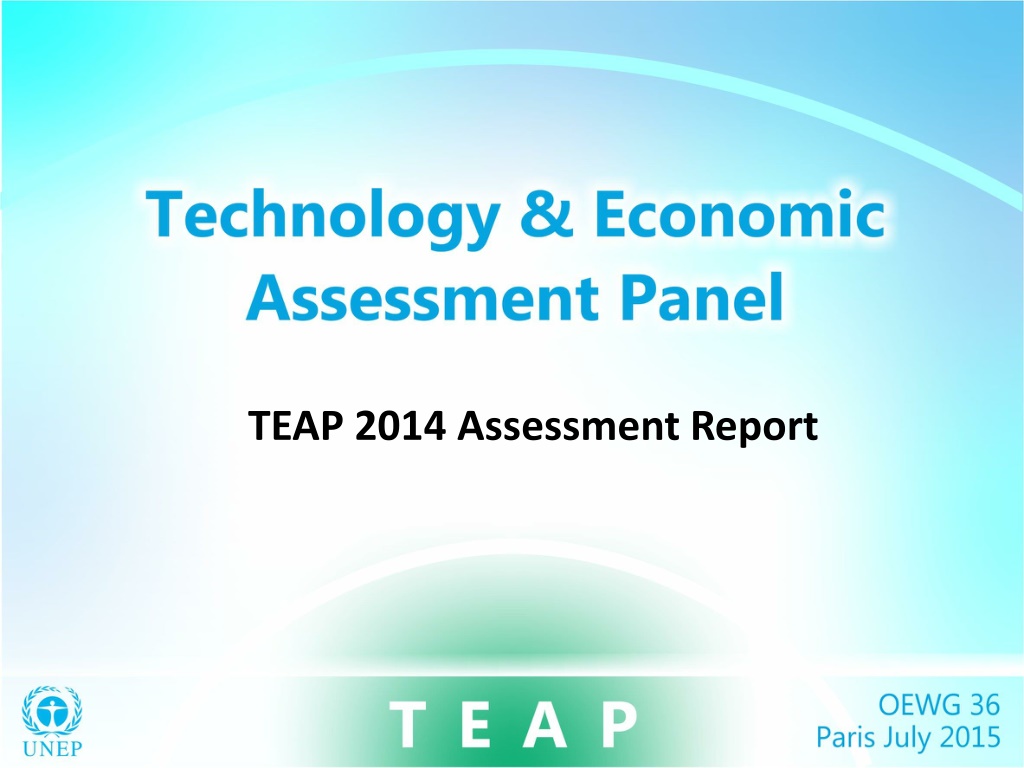


 undefined
undefined




